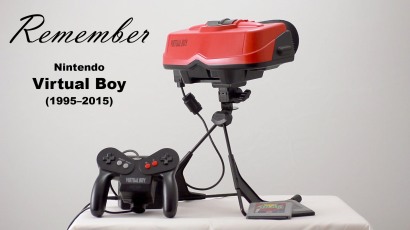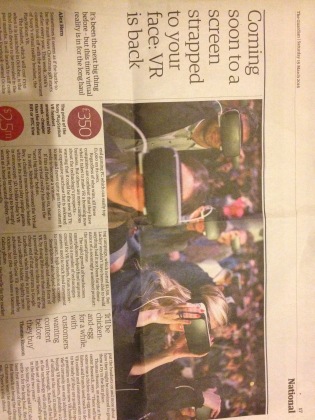Here is the link for my Concept Proposal PDF file:
Monthly Archives: March 2016
Contextual Analysis
Here is the link for my Contextual Analysis PDF file:
Newspaper Headline: 24/03/2016
Coming Soon to a Screen Strapped to your Face: VR is back!
The headline in The Guardian 19/03/2016. The article focused on the competition between Playstation VR, the Oculus Rift and the HTC Vive. No matter which company comes out on top all three believe they have the technology and know how to make VR a booming new business though others are not so positive believing it could be the new 3D TV, an expensive buy that never gained popularity. In 1995 Nintendo released Virtual Boy which failed partly due to it’s clunky headset.
VRs revival is due to Palmer Luckey, founder of the Oculus rift. He believes that the development of the smartphone was crucial to the improved technology of headsets eg, high resolution screens. The smartphone with cheap end headsets were already a VR product in their own right. How successful the revival of VR will be will be dependent on the content developed for users and the variety of uses. Initially it is thought there will be a niche market of gamers but for the long haul VR has to have an appeal to a much broader market.
Newspaper: The Guardian: Saturday 19 March 2016
VR in Space: 21/03/2016
It seems you can get have an alternative reality anywhere in the universe. Augmented reality really is ‘out of this world.’ Astronauts aboard the international space station played an augmented-reality game of space invaders.
On a more serious note Tim Peak and Scott Kelly are experimenting with a new augmented reality programme working in combination with mission control to provide a much better understanding of what is happening on the space station. Ground control and the astronauts come into the virtual world to complete tasks together. This project has been called ‘Project Sidekick.’
Never before has virtual reality been used in so many applications. It is not just for gaming or entertainment but has real uses as well. The future looks bright for VR.
http://news.sky.com/story/1663698/tim-peake-plays-space-invaders-in-space
http://www.bbc.co.uk/newsround/35863172
CyberSpace: 19/03/2016
Cyberspace?
‘Cyberspace is a conceptual electronic space unbounded by distance or other physical limitations.’ William Gibson conceived this term in book Neuromancer (1982). It described the global information network where we create data in graphic and digital form. It is an imaginary non physical space and where this information ends up in. As the internet took off, this belief has become everted into the physical world (Emergence of Digital Humanities, 2013). This digital dualism can be seen in how virtual social networking sites have started taking over how we handle our ‘real’ lives (The New Inquiry, 2012). Technology today is interdependent of each other.
Gibson’s influence is evident in the movie franchise The Matrix.
Emergence of Digital Humanities (2013) Eversion Available at: http://emergenceofdhbook.tumblr.com/post/59772273737/you-can-now-read-the-introduction-at-the (Accessed: 18 March 2016)
The New Inquiry (2012) The Myth of Cyberspace Available at: http://thenewinquiry.com/essays/the-myth-of-cyberspace/ (Accessed: 18 March 2016)
Use of the Internet
The internet is being used differently to how the creators had envisaged, therefore free from regulations and a platform for shared interests and new ideas. Many of the power players have conflicting interests and everyone is trying to control it. Governments are powerless to make policies because companies will transfer to another country where the laws are more relaxed. Multi-national companies are in ongoing ‘tussles’ to control the internet. Some tussles might be conflicting but other times tussles are for complimentary purposes, therefore user sending data that a provider will carry for a price. Without one another the internet would not be able to be used as intended.
http://david.choffnes.com/classes/cs4700fa14/papers/tussle.pdf (Accessed: 18 March 2016)
My Ideas
Ideas
Virtual reality is the first step in a grand adventure into the landscape of the imagination. (Biocca, Kim and Levy, 1995, p.6)
VR is all about letting your imagination go wild. Experience and go to places that you never thought possible and a place for dreams to come true, for at least a little while. I think it would be exciting to create applications according to people’s dreams. It would almost seem like it is tailor made for an individual. For example become Messi or Steven Gerrard, beat Lewis Hamilton in a car race or race alongside Usain Bolt, climb Mount Everest, come first in sports day at school or become the top dog at work.
More Ideas
How about creating applications for children to experience a day at work. Many students are often confused for their career choices and it would be ideal to let them experience different careers in VR. For example become a teacher, builder, nurse, office worker, Tv presenter or even the prime minister.
Applications VR : 17/03/2016
Applications
VR is being used in a wide range of applications. It is not just for gaming or entertainment.
Military:
- Flight and battle simulation
- Weapons training
- Medic training
Education:
- Historical events
- Geographical expeditions
- Space exploration
Healthcare:
- Surgical simulations
- Helping overcome disabilities
- Overcome phobias
- Pain reduction
Engineering
- Bridge construction
- Building construction
- Transport design
- Machinery design
Do we want VR? : 15/03/2016
Do we want VR?
It is reported that less than 1% of PCs used globally will have the power to facilitate the high end virtual reality devices. So why are forecasters suggesting 2016 will the year VR will finally take off? Despite the high price the Oculus Rift has exceeded expectations and new pre-orders are being delayed. 15000 HTC Vives were sold in the first 10 minutes when released on 29th February 2016. Sony has undercut the other two headsets and announced on 15th March 2016 that it will sell the Playstation VR for $399 and predicted 1.6 million headsets will be sold before 2017. Samsungs Gear VR sold out when released in November 2015 helped by its price of $99. Is this a novelty or is VR here to stay? Well over five million Google cardboards have already been shipped since 2014, 25 million Google cardboard apps have been downloaded and 350,000 hours of VR video has been seen. Even though the Google Cardboard and Samsung Gear VR use smartphones for the VR experience and do not have the quality of immersion as the more expensive devices, they are a good early indication that consumers are enjoying the VR experience and more likely to spend money to get the best reality experience.
http://www.bbc.co.uk/news/technology-35220974
http://www.roadtovr.com/founder-oculus-rift-pre-orders-going-much-better-than-expected-sales/
http://www.bbc.co.uk/news/technology-35813653
http://phys.org/news/2016-01-google-cardboard-shipped-million-virtual.html
Health Risks of VR : 11/03/2016
Health Risks
There are reported side effects to virtual reality and consequently many brands have put an age limit of 13. Many believe that these companies are simply covering themselves. Professor Peter Howarth, an optometrist and expert on stereoscopic displays believes that there is no significant risk to children. (VentureBeat, 2016) There is a long list of health and safety warnings, which are provided with these devices but again many believe it is simply to cover themselves from liability. If these side effects were as dangerous as to cover them with all these warnings many believe that VR projects would never have had billions invested in them and the excitement and momentum being created would not have happened.
Side effects:
- Motion sickness
- Stress
- Anxiety
- Eye strain
- Nausea
How to counteract these:
- Allow movement in the direction the user is facing but can be limiting to using applications.
- Creating less complex textures on the images and reducing player motion can avoid vection, where your brain is being tricked into movement.
- Keep turns and jumps to a minimum and reduce side to side motion.
- Have lighter headsets.
- Provide natural eye optics to provide comfortable viewing and reduce eye strain.
VentureBeat (2016) We are not talking about what VR is doing to our eyes…Available at: http://venturebeat.com/2015/04/18/were-not-talking-about-what-vr-is-doing-to-our-eyes-and-our-brains/
(Accessed 11 March 2016)
Consumer Thoughts…. : 08/03/2016
What do people think about virtual reality?
The tech industry believes VR and AR will be the latest craze and change life as television, computers, smartphones and the internet have done previously. The difference though is that VR is a tried and tested technology, which failed during its introduction to the mainstream during the 90s. Initially films like Tron (1982) and later The Lawnmower Man (1992) made audiences believe that an interactive world was well within reach. It did not live up to expectations with rudimentary technology and worlds that did not provide the immersive experience as promised. This time round with advancements in technology and consumer devices industry specialists believe VR is going to become a totally immersive experience in the world of games, entertainment and other applications eg. health, education and will be here to stay. The question is though what do consumers think of this reincarnation….
Worldwide, only 23 percent of people are convinced virtual reality is as good as the real thing, according to a survey by analyst firm GfK
http://www.cnet.com/news/virtual-reality-to-eclipse-phones-in-your-digital-life/


